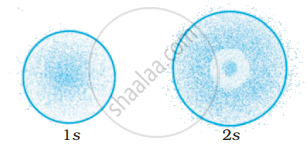Advertisements
Advertisements
प्रश्न
Write condensed orbital notation of electronic configuration of the following element:
Oxygen (Z = 8)
उत्तर
| Element | Condensed orbital notation |
| Oxygen (Z = 8) | [He] 2s2 2p4 |
APPEARS IN
संबंधित प्रश्न
Using s, p, d notations, describe the orbital with the following quantum numbers n = 4; l = 2.
Choose the correct option.
p-orbitals are _________ in shape.
Define the term Electronic configuration
State the order of filling atomic orbitals following Aufbau principle.
Write condensed orbital notation of electronic configuration of the following element:
Calcium (Z = 20)
Draw shapes of 2s orbitals.
Explain in brief, the significance of the azimuthal quantum number.
If n = 3, what are the quantum number l and m?
Indicate the number of unpaired electron in:
Cr (Z = 24)
How many electrons in 19K have n = 3, l = 1?
The three electrons have the following set of quantum numbers:
X = 6, 1, −1, `+1/2`
Y = 6, 0, 0, `+1/2`
Z = 5, 1, 0, `+1/2`
Identify the CORRECT statement.
Which one of the following is NOT possible?
The probability density plots of 1s and 2s orbitals are given in Figure:

The density of dots in a region represents the probability density of finding electrons in the region.
On the basis of above diagram which of the following statements is incorrect?
Number of angular nodes for 4d orbital is ______.
The pair of ions having same electronic configuration is ______.
Which of the following statements concerning the quantum numbers are correct?
(i) Angular quantum number determines the three dimensional shape of the orbital.
(ii) The principal quantum number determines the orientation and energy of the orbital.
(iii) Magnetic quantum number determines the size of the orbital.
(iv) Spin quantum number of an electron determines the orientation of the spin of electron relative to the chosen axis.
Nickel atom can lose two electrons to form \[\ce{Ni^{2+}}\] ion. The atomic number of nickel is 28. From which orbital will nickel lose two electrons.
Which of the following orbitals are degenerate?
3dxy, 4dxy 3dz2, 3dyz, 4dyz, 4dz2
The arrangement of orbitals on the basis of energy is based upon their (n + l) value. Lower the value of (n + l), lower is the energy. For orbitals having same values of (n + l), the orbital with lower value of n will have lower energy.
Based upon the above information, arrange the following orbitals in the increasing order of energy.
5p, 4d, 5d, 4f, 6s
The arrangement of orbitals on the basis of energy is based upon their (n + l) value. Lower the value of (n + l), lower is the energy. For orbitals having same values of (n + l), the orbital with lower value of n will have lower energy.
Based upon the above information, arrange the following orbitals in the increasing order of energy.
5f, 6d, 7s, 7p
The electronic configuration of valence shell of Cu is 3d104s1 and not 3d94s2. How is this configuration explained?
Match the following
| (i) Photon | (a) Value is 4 for N shell |
| (ii) Electron | (b) Probability density |
| (iii) ψ2 | (c) Always positive value |
| (iv) Principal quantum number n | (d) Exhibits both momentum and wavelength |
Match species given in Column I with the electronic configuration given in Column II.
| Column I | Column II |
| (i) \[\ce{Cr}\] | (a) [Ar]3d84s0 |
| (ii) \[\ce{Fe^{2+}}\] | (b) [Ar]3d104s1 |
| (iii) \[\ce{Ni^{2+}}\] | (c) [Ar]3d64s0 |
| (iv) \[\ce{Cu}\] | (d) [Ar] 3d54s1 |
| (e) [Ar]3d64s2 |
Which of the following is the correct plot for the probability density ψ2 (r) as a function of distance 'r' of the electron from the nucleus for 2s orbitals?
Which of the following is not the permissible arrangement of electrons in an atom?
In assigning R - S configuration, which among the following groups has highest priority?
Which one of the following laws will represent the pairing of electrons in a subshell after each orbital is filled with one electron?
